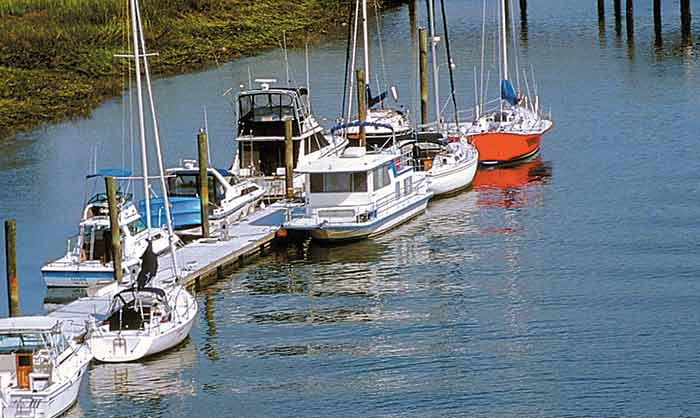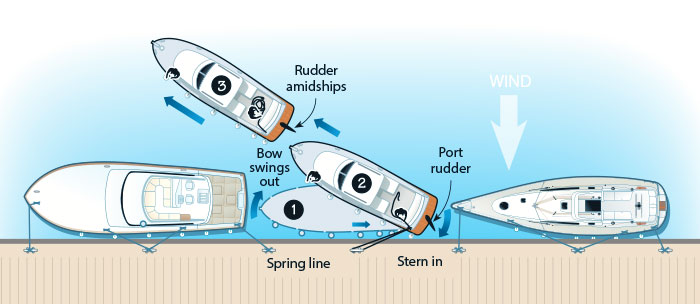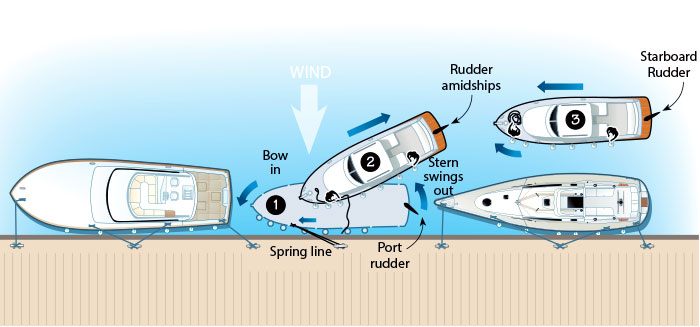Advertisement
With one easy-to-learn technique, leaving a tricky dock can be simple, whether you have bow and stern thrusters — or not.

Wind blowing against a dock or pier can help you get into a tight berth to leeward, but getting out again with wind pinning your boat against the dock can be a challenge. Bow and stern thrusters can be a godsend here, but what if you don't have thrusters or the wind is too strong? Using spring lines, combined with the thrust of the engine and the position of the rudder, you may be able to get yourself out if you know the tactics and are familiar with your boat.
Tip
Nylon is the rope of choice for spring lines, as these lines need some stretch.
The technique described here is for boats with a single engine, but should you have twins, it may help to put one astern and the other ahead to help spin the boat. Different boats perform differently; it's important to be familiar with yours.
If the wind is too strong or you don't think you have a reasonable chance of success, it may be best to wait it out until the wind dies down. Also, always beware of current. For example, current running against the slant of your rudder may add to or negate the flow from the prop.
Suppose that your boat is between two others with only a few feet of clearance at the bow and stern. If you merely cast off the lines and try to motor out as you normally would, there's a good chance you'll hit the boat in front, the one behind, or both. However, using a line from the bow or stern of your boat doubled around a cleat or piling on the dock, then back to the boat, you can then motor against the line tension to swing out the bow or stern. As the tension is taken up and the rudder turned, the boat should pivot and swing clear; then you can safely motor out, clearing the boats around you.
It does take practice and familiarity with the characteristics of your boat. Communication is key, and you should brief your crew before starting the maneuver so each person knows his or her roles. Always use fenders to avoid hitting other boats and the dock, and watch out for overhanging dinghy davits, bow pulpits, or swim platforms, both on your boat and others. Keep hands, feet, and other body parts clear to avoid injury; tell your crew not to try to be heroes and risk injury if something goes awry. Now then, here's how to do it.
Leaving Bow First

Illustration: ©2017 Mirto Art Studio
Let's assume you want to leave the dock bow first in the situation described above. Tie off the forward spring line to the aft cleat, then double it up around a very strong cleat or piling on the dock that's aft of the bow of the boat. How far aft will depend on your boat's characteristics and circumstances, such as wind strength and the proximity of other boats.
Cleats on docks and boats can be lethal weapons if they come loose. Check them carefully before creating this extra stress. It's sometimes safer and easier to wrap the line around a piling on the dock, not around a dock cleat. Take one turn only around the cleat on the boat with the bitter (free) end so it can be released quickly.
1. Get one crew member to cast off the forward docklines and be ready with a fender in case you get too close to the boat in front. Get another crew member to cast off the stern line, leaving just the forward spring in position. The aft crew should also have a fender to protect the rear corner of the boat.
2. Slowly put the engine in reverse with the rudder centered until tension is taken up on the forward spring line. Turn the wheel or move the tiller until the rudder is pointed toward the dock. Get your crew to put a fender between the dock and the boat. Apply a little more reverse throttle, and the bow should start to swing out, away from the dock. With the bitter end of the line around the cleat, the aft crew will be able keep tension on the spring line and monitor the position of the fender and boat so the boat is protected.
3. When the boat is pointing so that it will well clear the boat ahead, shift to forward and move the rudder to turn the boat away from the dock and the boat that's on the dock forward of you. As the tension comes off the spring line, have your crew drop the bitter end and bring the line back on board quickly so the propeller doesn't catch it.
As you steer away from the dock, you may need to increase speed slightly to get well clear. As you turn out, make sure that your stern doesn't turn in, clipping the boat ahead. Have the crew ready with the fender until you're certain that you won't bump into any other boats.
Leaving Stern First

Illustration: ©2017 Mirto Art Studio
There are times when it is advantageous to leave the dock stern first, and with some boats, this may be easier than going out bow first.
1. Release all the lines with the exception of the stern spring. Put the engine in gear and slowly motor forward until the tension comes up on the spring line. Have the bow crew position a fender between bow and dock. Carefully steer the boat toward the dock.
2. Increase the throttle a little, and the stern should start to move away from the dock, angling well out from any boat behind you. Reposition the bow fender as needed while keeping tension on the spring line.
3. Bring the rudder back the other way, steering away from the dock as you put the engine in reverse. As the spring line goes slack, the crew on the bow drops the bitter end and swiftly brings the line back on board.
The crew should be ready with fenders until you're well clear of the dock and other boats.
In either maneuver, if the wind is strong, it's possible that you may find yourself sliding back toward the dock and boats, particularly if you don't angle out enough. Depending on your boat's characteristics (such as its profile above and below the waterline, which affects windage and resistance), you may find your bow or stern first moving back into the dock and other boats. It helps to practice and be familiar with your boat.
